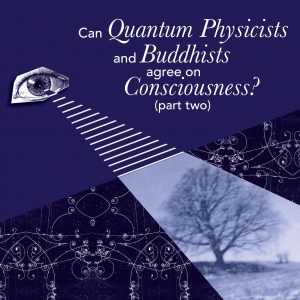
Join part two of this lively conversation with Professor Bogdan Staszewski of University College Dublin, a pioneer in building quantum computers, and Professor Doug Powers of Dharma Realm Buddhist University, a long-term Buddhist practitioner and professor of philosophy.
Is Consciousness in the Universe or is the Universe in Consciousness?
Until very recently, religion, or, more broadly, spirituality, was deemed utterly incompatible with science. The latter deals exclusively with the physical matter and energy that can be objectively measured by any “scientist” (including high-school science project participants), whereas the former mainly deals with issues “inside one’s head”, which are only known to a single “observer” (and perhaps their deities, in some religions). One of the greatest philosophers, Rene Descartes, formulated this as the mind-body problem, arguably the greatest mystery that still eludes scientists and philosophers.
Classical physics, as established by giants like Isaac Newton, has become so successful because it can precisely predict all future states of matter and energy by knowing their current state. On the other hand, spirituality/religion implies the notion of consciousness and free will. But how can a bunch of moving atoms (i.e., one’s brain, body, environment, etc.) give rise to consciousness, which can then arbitrarily affect the atoms’ future state? This paradox was reformulated in 1995 by Chalmers as the “hard problem of consciousness”, in contrast to “easy” problems like sending humans to Mars.
Quantum physics has slowly started to change all of this. One of its core tenets, true randomness, has removed the biggest obstacle to the concept of free will. Another core tenant, “the observer” that causes the wave function to collapse, appears to be a good candidate for consciousness. Some leading physicists (John von Neuman and Eugene Wigner) have postulated that consciousness is the explanation for the paradox of Schrodinger’s cat, which cannot possibly be explained by the early scientific model in which consciousness is entirely ignored or is, at best, a derivative of matter. In that new model, the observing consciousness is nonphysical and qualitatively different from the wave function but causes its collapse into what we perceive as the “world”.
Can Quantum Physicists and Buddhists Agree on Consciousness?
The ancient “mind scientists” that formulated the Yogacara school of thought in Buddhism might have come to similar conclusions, though couched in different terms. The evolution of the wave function due to energy (‘seeds’ or bijas?) could be the substratum consciousness (alayavijnana), whose collapse (the six consciousnesses) by the conscious observer (Tathagatagarbha?) gives rise to individually perceived matter (rupa). Tying all this together would be karma, which based on the feeling and perception skandhas makes the “free will” decision (activity skandha) that affects the energy (bijas) shaping the future evolution of the wave function.
Whether science (represented by the latest theories of quantum physics) and spirituality (represented by ancient Yogacara) can finally come to an agreement on consciousness will be discussed during this event.

Missed out on part one? No worries! Check out the recording here.